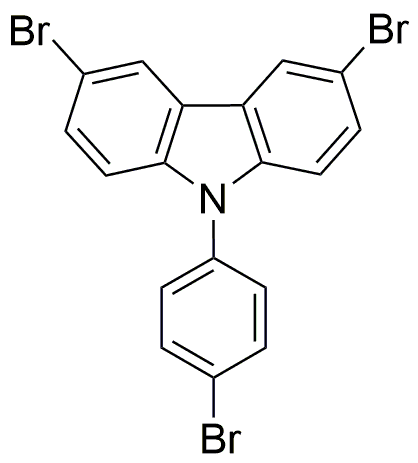3,6-Dibromo-9-(4-bromophenyl)carbazole is widely utilized in research focused on:
- Organic Electronics: This compound serves as a key material in the development of organic light-emitting diodes (OLEDs), enhancing their efficiency and color purity.
- Photovoltaic Cells: It is used in the fabrication of organic solar cells, contributing to improved energy conversion efficiency and stability under various environmental conditions.
- Fluorescent Dyes: The compound acts as a fluorescent marker in biological imaging, allowing for precise tracking of cellular processes in research and diagnostics.
- Polymer Chemistry: It plays a significant role in synthesizing high-performance polymers, which are crucial for applications in coatings and adhesives.
- Pharmaceutical Research: The compound is investigated for its potential as a therapeutic agent, particularly in studies related to cancer treatment due to its unique structural properties.
General Information
Properties
Safety and Regulations
Applications
3,6-Dibromo-9-(4-bromophenyl)carbazole is widely utilized in research focused on:
- Organic Electronics: This compound serves as a key material in the development of organic light-emitting diodes (OLEDs), enhancing their efficiency and color purity.
- Photovoltaic Cells: It is used in the fabrication of organic solar cells, contributing to improved energy conversion efficiency and stability under various environmental conditions.
- Fluorescent Dyes: The compound acts as a fluorescent marker in biological imaging, allowing for precise tracking of cellular processes in research and diagnostics.
- Polymer Chemistry: It plays a significant role in synthesizing high-performance polymers, which are crucial for applications in coatings and adhesives.
- Pharmaceutical Research: The compound is investigated for its potential as a therapeutic agent, particularly in studies related to cancer treatment due to its unique structural properties.
Documents
Safety Data Sheets (SDS)
The SDS provides comprehensive safety information on handling, storage, and disposal of the product.
Product Specification (PS)
The PS provides a comprehensive breakdown of the product’s properties, including chemical composition, physical state, purity, and storage requirements. It also details acceptable quality ranges and the product's intended applications.
Certificates of Analysis (COA)
Search for Certificates of Analysis (COA) by entering the products Lot Number. Lot and Batch Numbers can be found on a product’s label following the words ‘Lot’ or ‘Batch’.
Numéro de catalogue
Numéro de lot/série
Certificates Of Origin (COO)
This COO confirms the country where the product was manufactured, and also details the materials and components used in it and whether it is derived from natural, synthetic, or other specific sources. This certificate may be required for customs, trade, and regulatory compliance.
Numéro de catalogue
Numéro de lot/série
Safety Data Sheets (SDS)
The SDS provides comprehensive safety information on handling, storage, and disposal of the product.
DownloadProduct Specification (PS)
The PS provides a comprehensive breakdown of the product’s properties, including chemical composition, physical state, purity, and storage requirements. It also details acceptable quality ranges and the product's intended applications.
DownloadCertificates of Analysis (COA)
Search for Certificates of Analysis (COA) by entering the products Lot Number. Lot and Batch Numbers can be found on a product’s label following the words ‘Lot’ or ‘Batch’.
Numéro de catalogue
Numéro de lot/série
Certificates Of Origin (COO)
This COO confirms the country where the product was manufactured, and also details the materials and components used in it and whether it is derived from natural, synthetic, or other specific sources. This certificate may be required for customs, trade, and regulatory compliance.


